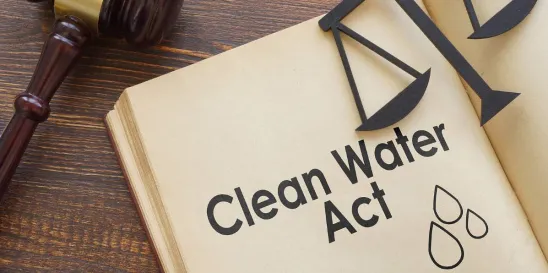Update: On June 26, 2023, EPA announced that it will redefine “waters of the United States” by September 1, 2023 to conform to the Sackett v. EPA jurisdictional limitations.
On May 25, the U.S. Supreme Court issued its long-awaited decision in Sackett v. EPA, No. 21-454, holding that Clean Water Act (CWA) jurisdiction extends to wetlands only if they have a continuous surface connection to relatively permanent bodies of water. The ruling is the latest (and some hope final) chapter in the saga to define the scope of federal jurisdiction over “waters of the United States” (WOTUS). The Court infamously exacerbated the controversy in its 2006 non-decision in Rapanos v. United States, where the Justices split 4-1-4 and issued two competing tests for evaluating CWA jurisdiction.
Fortunately, the Court avoided a similar outcome this time, with the opinion of Justice Alito commanding a five-Justice majority. Though narrow, that majority opinion has now set the standard for CWA jurisdiction over wetlands. In doing so, the Court undercut much of the Biden Administration’s recently-issued new definition of WOTUS, putting the U.S. Environmental Protection Agency (EPA) and the U.S. Army Corps of Engineers (Corps) in the position of having to rewrite that regulation for the fourth time in less than a decade.
Key Takeaways
-
EPA and the Corps may no longer apply the “significant nexus” test to assert CWA jurisdiction over wetlands.
-
Jurisdictional wetlands must have a “continuous surface connection” to relatively permanent bodies of water, which creates ambiguity as no guidance defines these terms. Jurisdiction is, therefore, still unclear for wetlands, especially those connected via ephemeral waters as well as seasonal features frequently found in the arid western U.S.
- EPA and the Corps will apply the 1986 regulatory standard, as modified by Sackett, until they develop a new, more “durable” definition for “waters of the United States.”
- Because the Court interpreted “waters of the United States,” which establishes jurisdictional boundaries for the CWA as a whole, the decision may limit CWA jurisdiction for other CWA programs where EPA attempts to assert jurisdiction beyond continuous surface waters. For example, oil spill control and containment plans are required to prevent spills into “navigable waters,” and Sackett could be read to limit EPA’s reach in this respect. The decision could also affect federal jurisdiction under a variety of other legislation where federal jurisdiction is triggered by activities affecting “navigable waters,” ranging from Oil Pollution Act to the Federal Power Act.
Background
The Sackett case arises from a long-running dispute over whether CWA jurisdiction extends to wetlands on the Sackett family’s rural Idaho homesite. Nearly ten years ago, the Supreme Court reversed the U.S. Court of Appeals for the Ninth Circuit, unanimously holding that the Sackett family had the right to challenge a compliance order from the EPA directing them to restore wetlands they had filled on the property when building their home.
Having won that battle, the Sacketts challenged the basis for EPA’s compliance order, arguing that the wetlands were not subject to federal jurisdiction under the CWA. The Sacketts asserted that EPA and the Corps inappropriately asserted jurisdiction over their wetlands by using Justice Kennedy’s "significant nexus" test from his concurring opinion in Rapanos v. United States. The Sacketts argued that the agencies instead should have relied on Justice Scalia’s narrower jurisdictional test from Rapanos, which provided that wetlands must have a “continuous surface connection” to a “relatively permanent” “water of the United States” for CWA jurisdiction to apply. But the Ninth Circuit again upheld the agencies’ position, and the Supreme Court again agreed to hear the case.
While the case was pending before the Court, EPA and the Corps issued a final rule hoping to create a lasting definition of WOTUS. In defining CWA jurisdiction, the rule relied in part on Justice Kennedy’s “significant nexus” test and identified specific factors to determine whether such a nexus exists. Multiple states and trade associations challenged the rule in multiple federal courts, resulting in two district courts granting preliminary injunctions preventing the rule from going into effect in dozens of states, as well as the Sixth Circuit staying the rule in Kentucky pending an appeal.
Ending a 17-Year Debate
Unlike Rapanos, Sackett leaves no doubt about the standard for determining when a wetland may be regulated under the CWA: the wetland must be “as a practical matter, indistinguishable from waters of the United States.” This occurs when wetlands have “a continuous surface connection to bodies that are ‘waters of the United States’ in their own right, so that there is no clear demarcation between ‘waters’ and wetlands.” In adopting this standard, the Court explicitly rejected the “significant nexus” test, ending nearly two decades of debate that followed the fractured Rapanos decision.
In reaching this holding, the Court also rejected the argument that the Act’s coverage of “adjacent” wetlands—acknowledged in Section 404(g)(1)—extends CWA jurisdiction to wetlands that are nearby, but separated from, relatively permanent surface waters. While acknowledging that the plain meaning of “adjacent” would include wetlands that are merely nearby, the Court concluded that including such wetlands could not be squared with its interpretation of the term “waters of the United States.” That interpretation demands jurisdictional waters to be relatively permanent and that wetlands be effectively “indistinguishable” from them.
The Court acknowledged, however, that temporary interruptions in surface connection may occur from low tides or dry spells, and such occurrences would not eliminate jurisdiction. However, the Court stated that barriers, unless illegally placed, would “ordinarily remove that wetland from federal jurisdiction.” Expect future litigation to focus on the types of temporary interruptions and barriers that would cut wetlands off from CWA jurisdiction.
Four Justices disagreed with the Court’s jurisdictional test, taking aim at its exclusion of wetlands that would be adjacent to permanent surface waters by virtue of being nearby. Justice Kavanaugh, joined by Justices Kagan, Sotomayor, and Jackson, stated that the new test conflates “adjacent” with “adjoining” wetlands and will carry significant repercussions for water quality and flood control by no longer covering some long-regulated adjacent wetlands.
This Supreme Court decision, while the latest attempt to discern the outer jurisdictional limits of the CWA, will undoubtedly initiate a new flurry of rulemakings and other activities in the now decades-long debate over WOTUS. Jurisdictional determinations, while finally free of the “significant nexus” test from Rapanos, likely will remain somewhat uncertain and inconsistent for the time being. While the scope of CWA jurisdiction over wetlands undoubtedly is narrower following Sackett – something more akin to jurisdiction under the now-vacated Navigable Waters Protection Rule – it could take some time for jurisdictional determinations to catch up to the new ruling with any semblance of uniformity. It is clear, however, that Sackett fundamentally dooms the Biden administration’s “durable” WOTUS definition, which has already been enjoined in 27 states. The agencies will likely issue guidance in the near future reverting CWA jurisdiction to the 1986 regulatory standard as modified by Sackett. We anticipate the agencies will shortly begin working to codify a new standard in another regulatory definition of WOTUS.
Erika Spanton, Allyn Stern, Tim Sullivan, and Jonas Reagan also contributed to this article.









 />i
/>i
